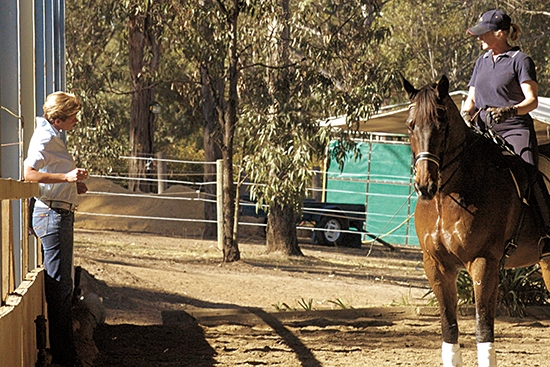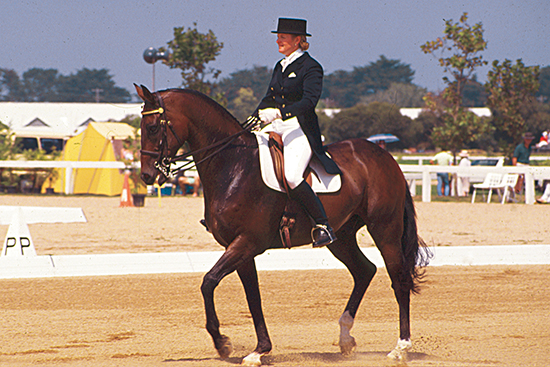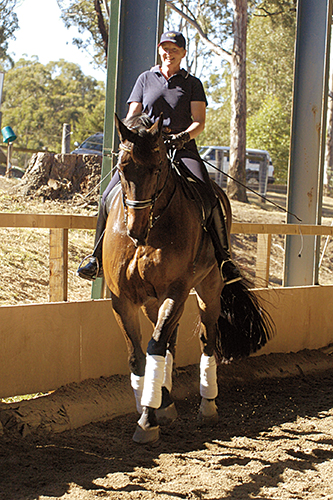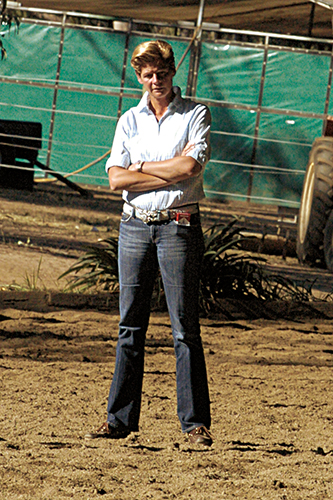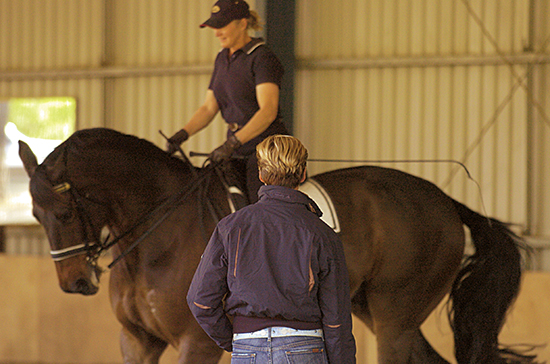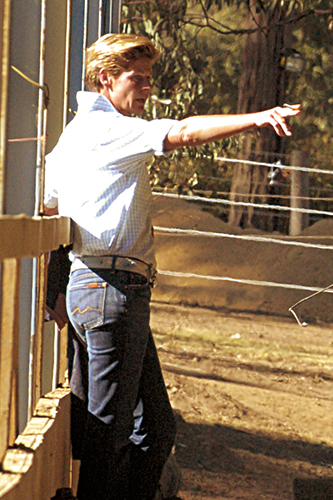STORY BY CHRIS HECTOR & PHOTOS BY ROZ NEAVE
At first it seemed like a crazy dream. Ulla Salzgeber, World Cup Champion, Olympic gold medallist, coming to coach the Australian dressage team – but not only did the German superstar arrive, last February, but having taught the squad, agreed to an ongoing role, and in June we saw Ulla back for her second clinic! This time instead of wasting Ulla’s time dragging her from the bottom end of our wide brown land to the top, the horses all came to Sydney, where once again Ann and Rick Serrao were the perfect hosts for a clinic.
And what’s more, Ulla had done her homework, for on the first night of the clinic, she assembled the riders for a video analysis of the tapes they had sent to her – and each and every one of them emerged from the session, encouraged and enlightened.
This clinic we decided to focus on two of the up-and-coming stars of Aussie dressage, Vickie Robertson and Kelly Layne. Vickie is part of the talent squad with her Northern Invader – the big bay gelding who has been dominating the Prix St Georges and Inter 1 classes. Kelly was riding her imported Hanoverian gelding, Amoucheur – both of them were familiar faces for Ulla since Kelly and ‘Smooch’ spent nine months with Ulla at her German training barn.
Vickie Robertson and her beautiful The Adjudicator in 1990
First it was time to catch up with Vickie Robertson and find out a little about her riding career…
When did you get the riding bug?
“I started riding before I really had a choice about it, two and a half. I don’t remember but apparently I could rise to the trot at two and a half, pretty amazing… I came up through pony club. I was taken hunting when I was about five. It was my older brother who started it all off. My family didn’t know much about horses. My father used to buy us unbroken ponies because they would last longer, so I got bucked off a thousand times. We were quite a big family – four of us would go hunting, and the cry would be, ‘look out, here come the Robertsons’ because we had no control of our ponies, we were pretty wild.”
“Even at the age of 12, I can remember I wanted to train – I had a pony that I trained every morning and every night. I’d had no lessons – other than pony club which you might as well count as nothing at that stage, but I just loved getting him out and doing what I thought was the right thing.”
“I also did jumping. I won the State Championships at Eventing, and I did showjumping and dressage at Pony Club.”
“I was born into the saddle really – I did three day eventing, Heath was eventing at the time too…”
Did you beat him?
“I don’t remember, but he did tell someone that he could never beat me, that was quite sweet. But I always loved the dressage side of it. I did a bit of showjumping also, my showjumpers were the best schooled. I’d had the odd lesson but my family couldn’t afford training, so it was a matter of just experimenting and sorting it out yourself.”
But then you came out and amazed the world with your beautiful Thoroughbred Grand Prix Dressage horse, The Adjudicator – you must have had someone helping you do that?
“Clemens Dierks. I bought a horse that I thought would be good to sell – that was The Adjudicator, my first dressage horse. I took him to Clemens, and he took us to Grand Prix, and this is no exaggeration, from our first flying change to competing in the Grand Prix at the CDI at Lochinvar in eight months. I was having a ball. I just followed what Clemens wanted me to do. The horse was very clever.”
You must have thought, gosh, this dressage is easy?
“No, I never thought it was easy but he was a very good horse. He was originally off the track, and a pony club girl had him. I gave her a few lessons, she wanted to sell him, he was pretty, seemed reasonably quiet. Actually when I took him home he was quite wild. He would settle but when you took him to a new place he would just blow. But then after two hours he would be absolutely bomb proof and you could do anything you liked. I found the harder you worked him the quieter he got.”
“I learnt a lot, then I spent many years going back over everything to understand it. I never thought it was easy, I didn’t have time, but I knew there was so much more to learn than that. I experimented on my own, even before I went to Clemens, I’d ridden a lot of Thoroughbreds off the track, and I did the rounding work. Not to the same degree as now, but I discovered that helped them relax and become very elastic and soft. Even before I went to Clemens, I could do that, and that helped me keep horses much softer – and because I rode mainly Thoroughbreds off the track, it let me re-adjust the problems they had. I worked at El Caballo for a year, and Manolo Mendez gave me what help he could with his limited English, he spoke of the muscles of the horse, that gave me an introduction to looking at the muscles and how they relax.”
So how did you travel from Thoroughbred to your present very large Warmblood?
“I had other Warmbloods first. I had Northern Cilesia, who is a full sister to Tiny (Northern Invader) and she was very successful. I went to look at some of the horses at the Stud, and there were a lot of very flashy horses, with their knees up round their ears, but this gawky big rising two year old walked out, and for some reason, there was something about his presence. I bought him. Took him home and he wouldn’t stop growing!”
“I had him broken at three, and at the time I hurt myself and wasn’t able to ride for five months. When I did start riding, I didn’t start on him, so he was left out in the paddock until he was four.”
“Luckily he was a gentle giant because you wouldn’t manage him otherwise…”
He has always been pretty fancy, I remember him doing a flying change in front of Christoph Hess, and Christoph saying ‘this is an international horse’ and what would he have been then six?
“Five. He took to the changes very quickly. That was one of the first things I taught him because his canter was so balanced.”
“The late Phil Fowles broke him in, and did a wonderful job, but when I first brought him in from the paddock after he had been left for a year, I thought I had bought the worst horse in the world! The only thing I could say he did was, stop. No steering, he leant down on the bit, he felt like he had chronic fatigue, just awful. Within a week of just asking him to give, he was just a totally different horse. He started to carry himself, started to move a lot better. Then I didn’t feel so bad about buying him.”
Coming to this clinic with Ulla, what was the aim?
“Probably the aim is to address all the little problems that we have. To gain as much information from Ulla as I can, to watch other riders, to talk with the other riders, just anything you can pick up at all.”
You had a little fall apart in your first session with Ulla?
“Well it was there before the clinic, it has been coming. He has been not wanting to come back from canter to trot, rolling up a little. Then we have been asking more of him recently with his piaffe and passage, he’s found an escape – you ask, he canters. I’m not too worried about it, but in many ways, it is good that it has happened here at the Ulla School, because here I’ve got the World Champion to help me!”
What has she suggested?
“Even by the end that first session with her, he had improved tremendously. Her solution was to keep asking, at times I had to turn him one way, turn him the other way, just keep asking, if he cantered, I had to come back into half steps, don’t even try trot, just half steps. When he made the half steps then we could go forward again in the trot, and just try and show him that there is really no escape there.”
Do you think that is one of our problems? We haven’t got Ulla’s experience, so when we get a problem like that, we are tempted to back off when the solution is to keep asking…
“Definitely, keep on asking but the situation has to be read correctly. I’m very confident that what we are doing will correct it. It is actually the direction I was heading but perhaps even more, but it is not done roughly…”
I think people get this wrong idea about Ulla, they hear that she is demanding but there is a big difference between demanding and abusive?
“In no way is it abusive. Perhaps that is how the problem started, we were asking a lot more energy in his piaffe / passage work, and maybe I pressed the wrong button, or backed off when I shouldn’t, or something like that, and so I have created this problem which probably was in there somewhere anyway – by developing and asking, we’ve brought it out, so it is a great time to address it. I came out of our first session thinking, okay that’s the worst lesson but by golly it is the best lesson I have had.”
What do you want to do with him?
“Ride Grand Prix, that’s all I’ve ever wanted to do. When I start training a horse, what I train for is to go Grand Prix, that’s why basics are so important, and you have to develop the basics all the way through. Keep going back over them, and developing, developing, all the time.”
At Aachen, at the WEG next year?
“If he’s ready, great.”
‘Tiny’ is perhaps not ready right now, but let’s all remember that the WEG is still 45 million seconds away as the Aachen press releases point out (in case your maths are a bit average, that’s about 14 months away) and the great thing about Tiny is that he has such honest basics, and with Ulla’s assistance, he seems so much more engaged, and seems to find the work easier.
Sure there were a few little canters off at the beginning but he came back to the job quickly and produced some stunning piaffe and passage steps and he really is not all that far from being a very impressive Grand Prix performer, and yes, Aachen may not be too soon.
Ulla gets Vickie to use two whips, and the minute they get a couple of nice piaffe steps it is ‘trot him out, trot him out’ then back again, and sure enough those steps get more and more impressive. Ulla is happy. “Now walk, and we do some passagey steps…”
Once again, no histrionics, no yelling or shouting, just quietly asking. “Make him rounder, both your legs more to the girth – now go rising trot with very quiet hands, now ask again…”
Lovely steps.
“Forward, forward, when you lose him forward, don’t get stuck in backwards, whip left, whip right, left, right, left, right…”
A few nice steps and they are out in trot again.
The wonderful thing here is that Ulla steps straight off the plane with her eyes and critical standards still well and truly in Germany. This is no trainer playing tourist telling us how wonderful we are, and by they way, ‘would you like to buy a horse?’ this is one of the world’s most professional trainers (remember that Ulla was a highly regarded trainer of young riders before she discovered Rusty and took to the competition ring again) and she is demanding that our riders give their absolute max.
“Now some more half steps (these are the little steps that proceed the piaffe steps), DON’T you move, he should move. Now some half steps on the spot, tiny, tiny half halts.”
Once again the result is excellent.
If there is one thing Ulla keeps coming back to time and time again, it is the position of the rider’s hands. Vickie is one of the best but this does not mean that she is not reminded as she starts the flying changes, ‘low hands put them on the saddle…”
“Make him more forward in the one times changes – YA – collect again, and do the changes again, and again, more forward, more expressive, that is nice.”
From flying changes to canter pirouette….
“Think about half pass as you ride the pirouette, and ride the pirouette in slow motion canter.” And Tiny proceeds to fall into walk.
“Try again, slow motion, now this rhythm is exactly what I want…” And it was beautiful.
On to the canter zig zag:
“We want a very high neck on the change, but the only way to get that high neck is (you guessed it) low hands. Vickie, look to your arms, ELBOWS! Yes, that is good.”
Again in the extended trot, Ulla is demanding a competition frame:
“In the extended trot I want your horse higher in the neck, longer in the neck. Give him rein, give him rein, give him rein! See nothing happened when you gave him the rein, he did not canter, he did not run away, you see that you can be softer with your hand.”
“Elbows, ELBOWS, ELBOWS – Vickie – I mean you. You are riding with a straight arm. That is better, now we ride the half passes, and bend his neck more. The nose should reach the track first. Come again, don’t let him come too fast, YA, that is good.”
Really good for Australia to have such a strong, exciting young horse starting out on a Grand Prix career. Really good to see Vickie Robertson ready to take her place at the highest level once again.
Over a cup of coffee in the break, our visitor has her sunny smile in place (not to mention the endless fag in her mouth, I do hope the body police from the Institute of Sport are not watching)…
It is nice that you have come back to Australia – it seems you must be happy with your little Aussies?
“My little Aussies… yes I am happy with them.”
Last night you had a video de-brief with them?
“Yeah we went through all their tests, and you see it today, it really helped them, they are thinking of more things…”
Looking at your lesson with Vickie, she was telling me that coming into the lesson she was having a problem with her horse – every time she asked for short steps or piaffe, he would canter out?
“She told me. Normally this problem happens when you do the exercise too often and too much. In the end, I told her, don’t do it one hour every day, she should play with it between the other exercises and keep him calm and quiet, and do the basics. Then she said to me, ‘yeah it could be I did a little bit too much in the last weeks’. I think because they knew I was coming, they wanted to make a big progress. These things happen.”
She said that it was interesting that you told her, don’t back off, keep asking for the steps until you get it?
“When something like that happens, I have to show her a way that is easy, a way she can follow – and I think we got it. The right recipe for her.”
The recipe was?
“I told her to keep her hands more quiet. I think she disturbed him a lot with the hand. When he stopped working, she tried with her hand to try and get him moving again. As long as her hands are still, everything is fine. A moving hand is never soft, a moving hand is always hard.”
You liked her to use the two whips to get more activity behind?
“He is not very electric on her spurs or leg and so it is easier for her with the whips, and it makes the horse more confident to find and hold the rhythm.”
In the passage, you were getting her to work one side, then the other?
“With the whips, always she has to touch the leg that is on the ground. This I find very difficult to do myself… there are some things with every rider. So I helped her by calling, right, left, or left, right, then she found the rhythm, then it was fine.”
And also the piaffe when she got it was very good?
“Very very good, also this transition that she rode – but she has to forget about piaffe / passage, piaffe / passage, she has to play with it, so that she gets more confident with it, and that she feels at home, play with this stuff, don’t be frightened that something will go wrong.”
It was like what you said to her in the extended trot, that she could give the reins and nothing bad happened…
“This is always there because the riders think that their horses will canter away. It was nice to see – he is flexing in every joint when he is doing the mediums, when she opens his frame and gives him the reins and leaves him more alone, he starts to stretch and to hold.”
In the canter pirouettes, you wanted them in a much slower rhythm?
“In the test she would never ride it this slow but I wanted her to ride it this slow, so she really controls every stride. You have to ride it slow to see if the rider can control it, stride by stride and you saw in the beginning, when he fell into a walk that she was not pushing enough with the inside leg – and it looks nicer when the pirouette is reduced, not so big.”
And in the changes, you wanted the horse more up?
“Yes, because if you hold them too tight and too short, where should they get the freedom in their shoulders to make a big change? It is not only a change, it is a flying change. To get the ‘flying’ you have to open the frame, and keep them up.”
In the half passes, you wanted a lot of bend in the neck, the nose to be the first thing to the track?
“Because they are all riding very parallel in the half passes, and I prefer – I don’t say it is correct – but I prefer the front legs a little in the lead, one hoof print, because I think it looks nicer, and I always got high marks for half passes, so it couldn’t be so wrong!”
With a horse like Northern Invader, is this a horse with the potential to go to Grand Prix?
“You never know it before they do the first Grand Prix test, there you have to put everything together. After a few tests you can say, perhaps.”
Would it be a good idea some time for you to come to Australia when the riders are going into a competition, so you can see them ride some tests under pressure?
“I have already seen the videos and I thought they were very interesting. That’s why I said to Debbie, can we make some video sessions? Because they all throw their marks away, only because they don’t think about it. So it was great when we did it, the riders were so interested in what I was telling them, and they got it in their heads, and really tried to do it, this is important. I’ll come back in November for Dressage with the Stars and for the Masterclass. I will come 14 days earlier, so I will get to work with the riders, and then see them compete.”
So it can’t be so terrible coming to Australia?
“No, I love this country and it is fun to work with the riders. As long as it is not raining like hell, or windy like hell, then it is fine, I am happy to come.”


